Fundamentals of Working Capital: Concepts, Components, and Estimation
VerifiedAdded on 2023/01/20
|13
|5443
|25
Homework Assignment
AI Summary
This assignment provides a comprehensive overview of working capital, a crucial aspect of business finance. It begins by defining working capital and differentiating between long-term and short-term funds, emphasizing the importance of working capital for day-to-day operations. The document explores various definitions and classifications of working capital, including the quantitative and qualitative concepts, also known as gross and net concepts. It delves into the structure of working capital, outlining the components of current assets and current liabilities and illustrating the circulation of working capital within a business. The assignment further categorizes working capital based on concepts (gross, net, and negative) and time (permanent and temporary), along with a classification based on financial reports like the Balance Sheet and Profit and Loss Account. It highlights the need for adequate working capital for smooth business operations, discussing the consequences of shortages or mismanagement. The document also covers the components of working capital, which is essential for maximizing shareholder value. This resource provides students with a detailed understanding of working capital, its importance, and its management within a business context.
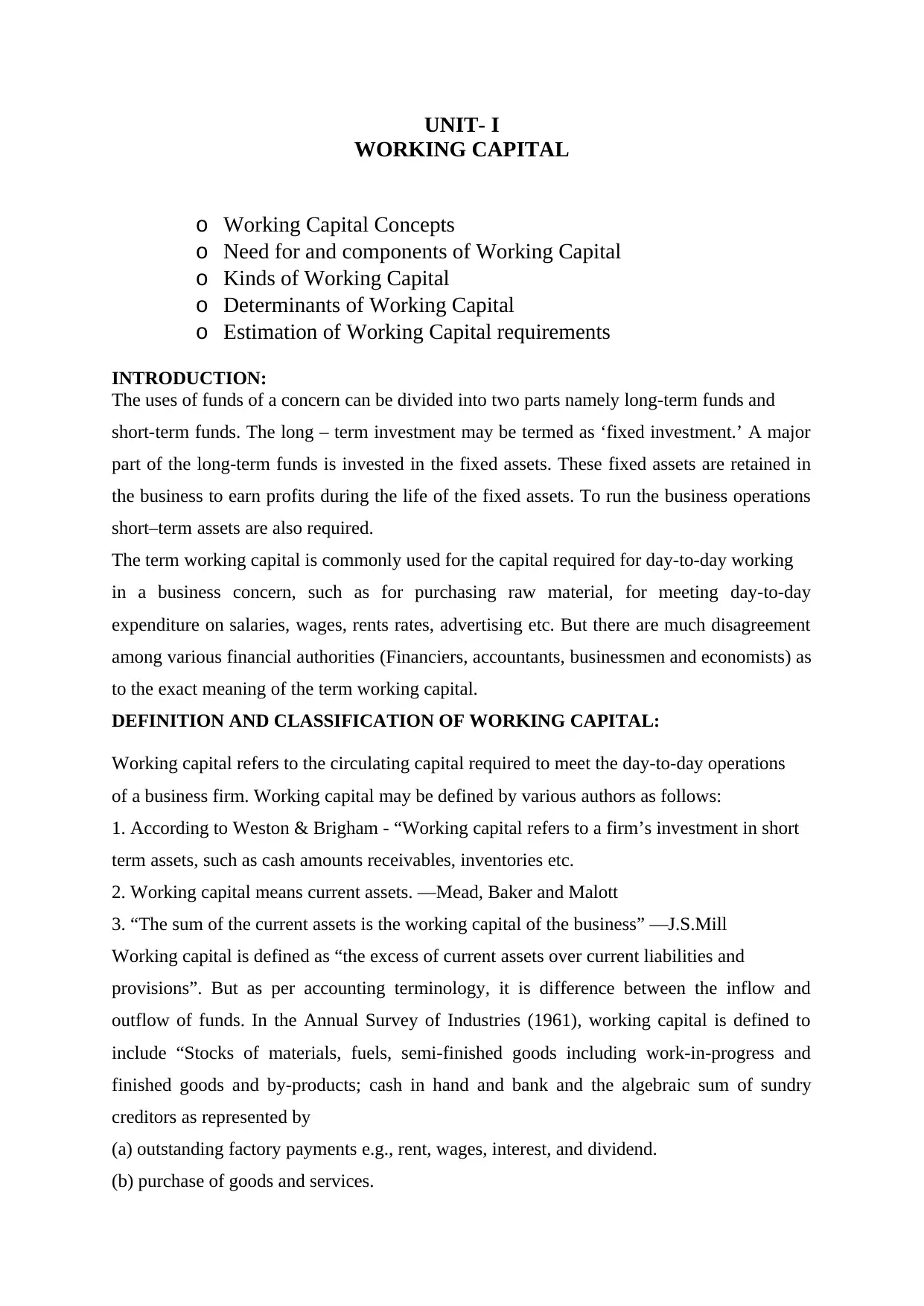
UNIT- I
WORKING CAPITAL
o Working Capital Concepts
o Need for and components of Working Capital
o Kinds of Working Capital
o Determinants of Working Capital
o Estimation of Working Capital requirements
INTRODUCTION:
The uses of funds of a concern can be divided into two parts namely long-term funds and
short-term funds. The long – term investment may be termed as ‘fixed investment.’ A major
part of the long-term funds is invested in the fixed assets. These fixed assets are retained in
the business to earn profits during the life of the fixed assets. To run the business operations
short–term assets are also required.
The term working capital is commonly used for the capital required for day-to-day working
in a business concern, such as for purchasing raw material, for meeting day-to-day
expenditure on salaries, wages, rents rates, advertising etc. But there are much disagreement
among various financial authorities (Financiers, accountants, businessmen and economists) as
to the exact meaning of the term working capital.
DEFINITION AND CLASSIFICATION OF WORKING CAPITAL:
Working capital refers to the circulating capital required to meet the day-to-day operations
of a business firm. Working capital may be defined by various authors as follows:
1. According to Weston & Brigham - “Working capital refers to a firm’s investment in short
term assets, such as cash amounts receivables, inventories etc.
2. Working capital means current assets. —Mead, Baker and Malott
3. “The sum of the current assets is the working capital of the business” —J.S.Mill
Working capital is defined as “the excess of current assets over current liabilities and
provisions”. But as per accounting terminology, it is difference between the inflow and
outflow of funds. In the Annual Survey of Industries (1961), working capital is defined to
include “Stocks of materials, fuels, semi-finished goods including work-in-progress and
finished goods and by-products; cash in hand and bank and the algebraic sum of sundry
creditors as represented by
(a) outstanding factory payments e.g., rent, wages, interest, and dividend.
(b) purchase of goods and services.
WORKING CAPITAL
o Working Capital Concepts
o Need for and components of Working Capital
o Kinds of Working Capital
o Determinants of Working Capital
o Estimation of Working Capital requirements
INTRODUCTION:
The uses of funds of a concern can be divided into two parts namely long-term funds and
short-term funds. The long – term investment may be termed as ‘fixed investment.’ A major
part of the long-term funds is invested in the fixed assets. These fixed assets are retained in
the business to earn profits during the life of the fixed assets. To run the business operations
short–term assets are also required.
The term working capital is commonly used for the capital required for day-to-day working
in a business concern, such as for purchasing raw material, for meeting day-to-day
expenditure on salaries, wages, rents rates, advertising etc. But there are much disagreement
among various financial authorities (Financiers, accountants, businessmen and economists) as
to the exact meaning of the term working capital.
DEFINITION AND CLASSIFICATION OF WORKING CAPITAL:
Working capital refers to the circulating capital required to meet the day-to-day operations
of a business firm. Working capital may be defined by various authors as follows:
1. According to Weston & Brigham - “Working capital refers to a firm’s investment in short
term assets, such as cash amounts receivables, inventories etc.
2. Working capital means current assets. —Mead, Baker and Malott
3. “The sum of the current assets is the working capital of the business” —J.S.Mill
Working capital is defined as “the excess of current assets over current liabilities and
provisions”. But as per accounting terminology, it is difference between the inflow and
outflow of funds. In the Annual Survey of Industries (1961), working capital is defined to
include “Stocks of materials, fuels, semi-finished goods including work-in-progress and
finished goods and by-products; cash in hand and bank and the algebraic sum of sundry
creditors as represented by
(a) outstanding factory payments e.g., rent, wages, interest, and dividend.
(b) purchase of goods and services.
Paraphrase This Document
Need a fresh take? Get an instant paraphrase of this document with our AI Paraphraser
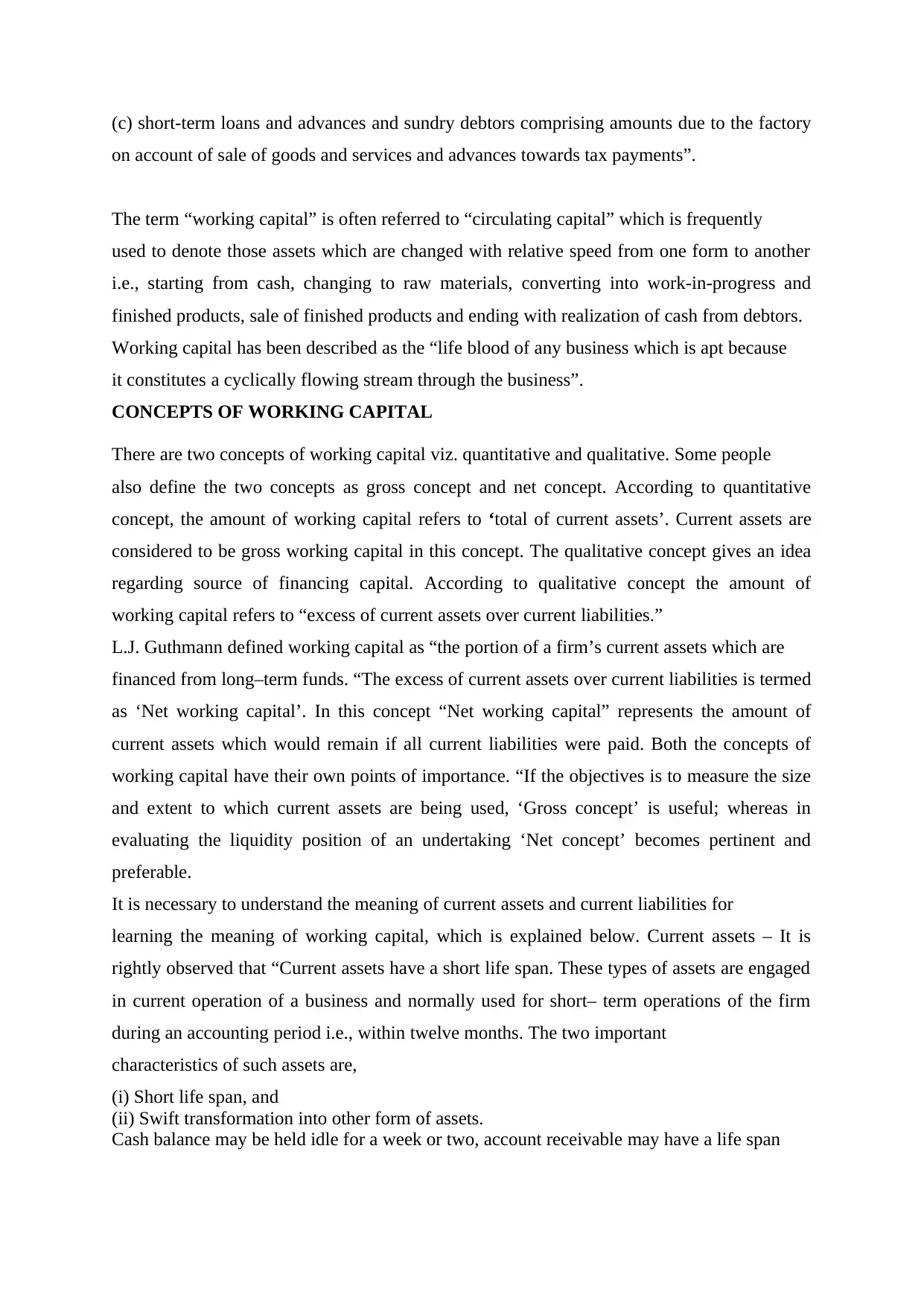
(c) short-term loans and advances and sundry debtors comprising amounts due to the factory
on account of sale of goods and services and advances towards tax payments”.
The term “working capital” is often referred to “circulating capital” which is frequently
used to denote those assets which are changed with relative speed from one form to another
i.e., starting from cash, changing to raw materials, converting into work-in-progress and
finished products, sale of finished products and ending with realization of cash from debtors.
Working capital has been described as the “life blood of any business which is apt because
it constitutes a cyclically flowing stream through the business”.
CONCEPTS OF WORKING CAPITAL
There are two concepts of working capital viz. quantitative and qualitative. Some people
also define the two concepts as gross concept and net concept. According to quantitative
concept, the amount of working capital refers to ‘total of current assets’. Current assets are
considered to be gross working capital in this concept. The qualitative concept gives an idea
regarding source of financing capital. According to qualitative concept the amount of
working capital refers to “excess of current assets over current liabilities.”
L.J. Guthmann defined working capital as “the portion of a firm’s current assets which are
financed from long–term funds. “The excess of current assets over current liabilities is termed
as ‘Net working capital’. In this concept “Net working capital” represents the amount of
current assets which would remain if all current liabilities were paid. Both the concepts of
working capital have their own points of importance. “If the objectives is to measure the size
and extent to which current assets are being used, ‘Gross concept’ is useful; whereas in
evaluating the liquidity position of an undertaking ‘Net concept’ becomes pertinent and
preferable.
It is necessary to understand the meaning of current assets and current liabilities for
learning the meaning of working capital, which is explained below. Current assets – It is
rightly observed that “Current assets have a short life span. These types of assets are engaged
in current operation of a business and normally used for short– term operations of the firm
during an accounting period i.e., within twelve months. The two important
characteristics of such assets are,
(i) Short life span, and
(ii) Swift transformation into other form of assets.
Cash balance may be held idle for a week or two, account receivable may have a life span
on account of sale of goods and services and advances towards tax payments”.
The term “working capital” is often referred to “circulating capital” which is frequently
used to denote those assets which are changed with relative speed from one form to another
i.e., starting from cash, changing to raw materials, converting into work-in-progress and
finished products, sale of finished products and ending with realization of cash from debtors.
Working capital has been described as the “life blood of any business which is apt because
it constitutes a cyclically flowing stream through the business”.
CONCEPTS OF WORKING CAPITAL
There are two concepts of working capital viz. quantitative and qualitative. Some people
also define the two concepts as gross concept and net concept. According to quantitative
concept, the amount of working capital refers to ‘total of current assets’. Current assets are
considered to be gross working capital in this concept. The qualitative concept gives an idea
regarding source of financing capital. According to qualitative concept the amount of
working capital refers to “excess of current assets over current liabilities.”
L.J. Guthmann defined working capital as “the portion of a firm’s current assets which are
financed from long–term funds. “The excess of current assets over current liabilities is termed
as ‘Net working capital’. In this concept “Net working capital” represents the amount of
current assets which would remain if all current liabilities were paid. Both the concepts of
working capital have their own points of importance. “If the objectives is to measure the size
and extent to which current assets are being used, ‘Gross concept’ is useful; whereas in
evaluating the liquidity position of an undertaking ‘Net concept’ becomes pertinent and
preferable.
It is necessary to understand the meaning of current assets and current liabilities for
learning the meaning of working capital, which is explained below. Current assets – It is
rightly observed that “Current assets have a short life span. These types of assets are engaged
in current operation of a business and normally used for short– term operations of the firm
during an accounting period i.e., within twelve months. The two important
characteristics of such assets are,
(i) Short life span, and
(ii) Swift transformation into other form of assets.
Cash balance may be held idle for a week or two, account receivable may have a life span
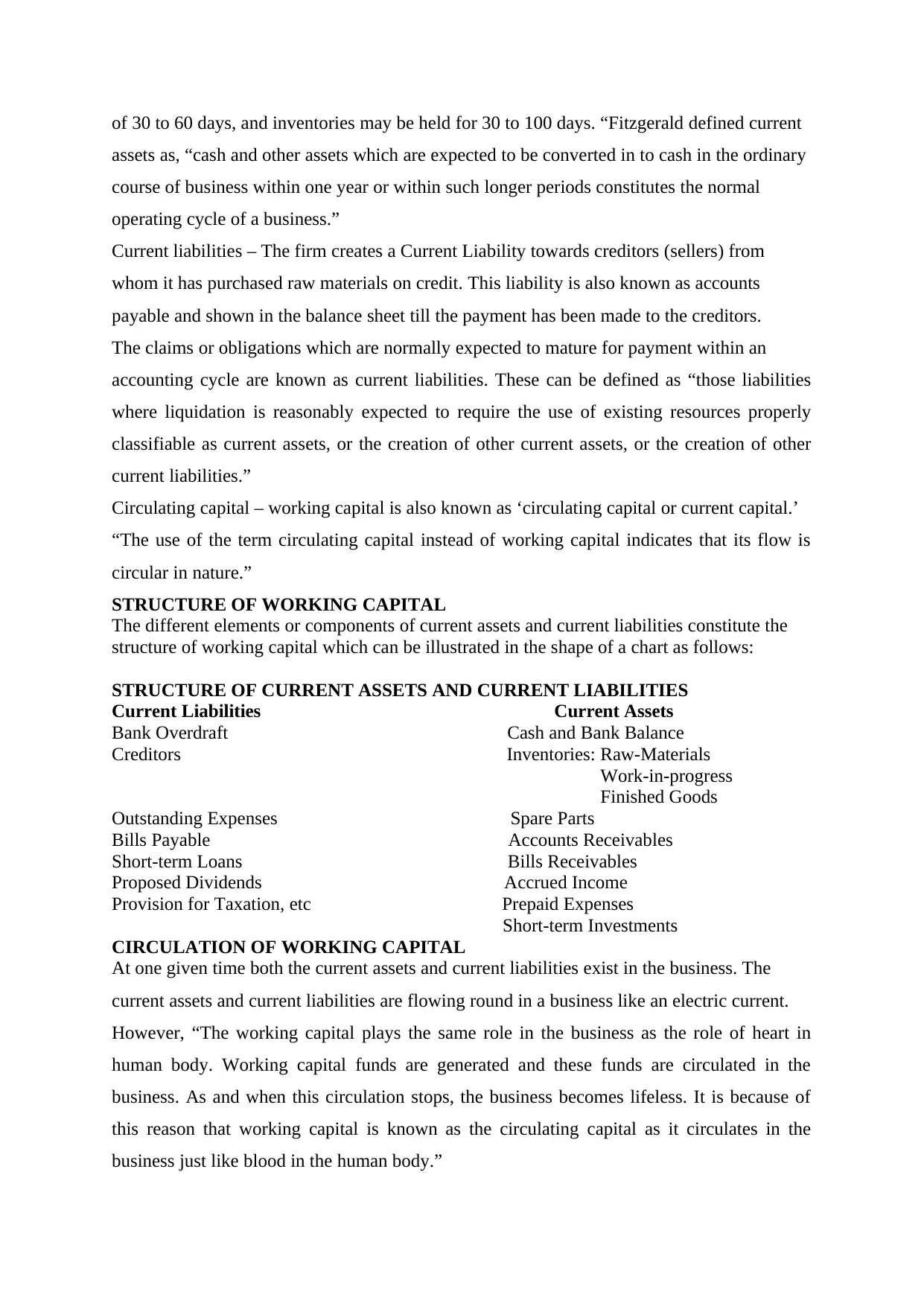
of 30 to 60 days, and inventories may be held for 30 to 100 days. “Fitzgerald defined current
assets as, “cash and other assets which are expected to be converted in to cash in the ordinary
course of business within one year or within such longer periods constitutes the normal
operating cycle of a business.”
Current liabilities – The firm creates a Current Liability towards creditors (sellers) from
whom it has purchased raw materials on credit. This liability is also known as accounts
payable and shown in the balance sheet till the payment has been made to the creditors.
The claims or obligations which are normally expected to mature for payment within an
accounting cycle are known as current liabilities. These can be defined as “those liabilities
where liquidation is reasonably expected to require the use of existing resources properly
classifiable as current assets, or the creation of other current assets, or the creation of other
current liabilities.”
Circulating capital – working capital is also known as ‘circulating capital or current capital.’
“The use of the term circulating capital instead of working capital indicates that its flow is
circular in nature.”
STRUCTURE OF WORKING CAPITAL
The different elements or components of current assets and current liabilities constitute the
structure of working capital which can be illustrated in the shape of a chart as follows:
STRUCTURE OF CURRENT ASSETS AND CURRENT LIABILITIES
Current Liabilities Current Assets
Bank Overdraft Cash and Bank Balance
Creditors Inventories: Raw-Materials
Work-in-progress
Finished Goods
Outstanding Expenses Spare Parts
Bills Payable Accounts Receivables
Short-term Loans Bills Receivables
Proposed Dividends Accrued Income
Provision for Taxation, etc Prepaid Expenses
Short-term Investments
CIRCULATION OF WORKING CAPITAL
At one given time both the current assets and current liabilities exist in the business. The
current assets and current liabilities are flowing round in a business like an electric current.
However, “The working capital plays the same role in the business as the role of heart in
human body. Working capital funds are generated and these funds are circulated in the
business. As and when this circulation stops, the business becomes lifeless. It is because of
this reason that working capital is known as the circulating capital as it circulates in the
business just like blood in the human body.”
assets as, “cash and other assets which are expected to be converted in to cash in the ordinary
course of business within one year or within such longer periods constitutes the normal
operating cycle of a business.”
Current liabilities – The firm creates a Current Liability towards creditors (sellers) from
whom it has purchased raw materials on credit. This liability is also known as accounts
payable and shown in the balance sheet till the payment has been made to the creditors.
The claims or obligations which are normally expected to mature for payment within an
accounting cycle are known as current liabilities. These can be defined as “those liabilities
where liquidation is reasonably expected to require the use of existing resources properly
classifiable as current assets, or the creation of other current assets, or the creation of other
current liabilities.”
Circulating capital – working capital is also known as ‘circulating capital or current capital.’
“The use of the term circulating capital instead of working capital indicates that its flow is
circular in nature.”
STRUCTURE OF WORKING CAPITAL
The different elements or components of current assets and current liabilities constitute the
structure of working capital which can be illustrated in the shape of a chart as follows:
STRUCTURE OF CURRENT ASSETS AND CURRENT LIABILITIES
Current Liabilities Current Assets
Bank Overdraft Cash and Bank Balance
Creditors Inventories: Raw-Materials
Work-in-progress
Finished Goods
Outstanding Expenses Spare Parts
Bills Payable Accounts Receivables
Short-term Loans Bills Receivables
Proposed Dividends Accrued Income
Provision for Taxation, etc Prepaid Expenses
Short-term Investments
CIRCULATION OF WORKING CAPITAL
At one given time both the current assets and current liabilities exist in the business. The
current assets and current liabilities are flowing round in a business like an electric current.
However, “The working capital plays the same role in the business as the role of heart in
human body. Working capital funds are generated and these funds are circulated in the
business. As and when this circulation stops, the business becomes lifeless. It is because of
this reason that working capital is known as the circulating capital as it circulates in the
business just like blood in the human body.”
⊘ This is a preview!⊘
Do you want full access?
Subscribe today to unlock all pages.

Trusted by 1+ million students worldwide
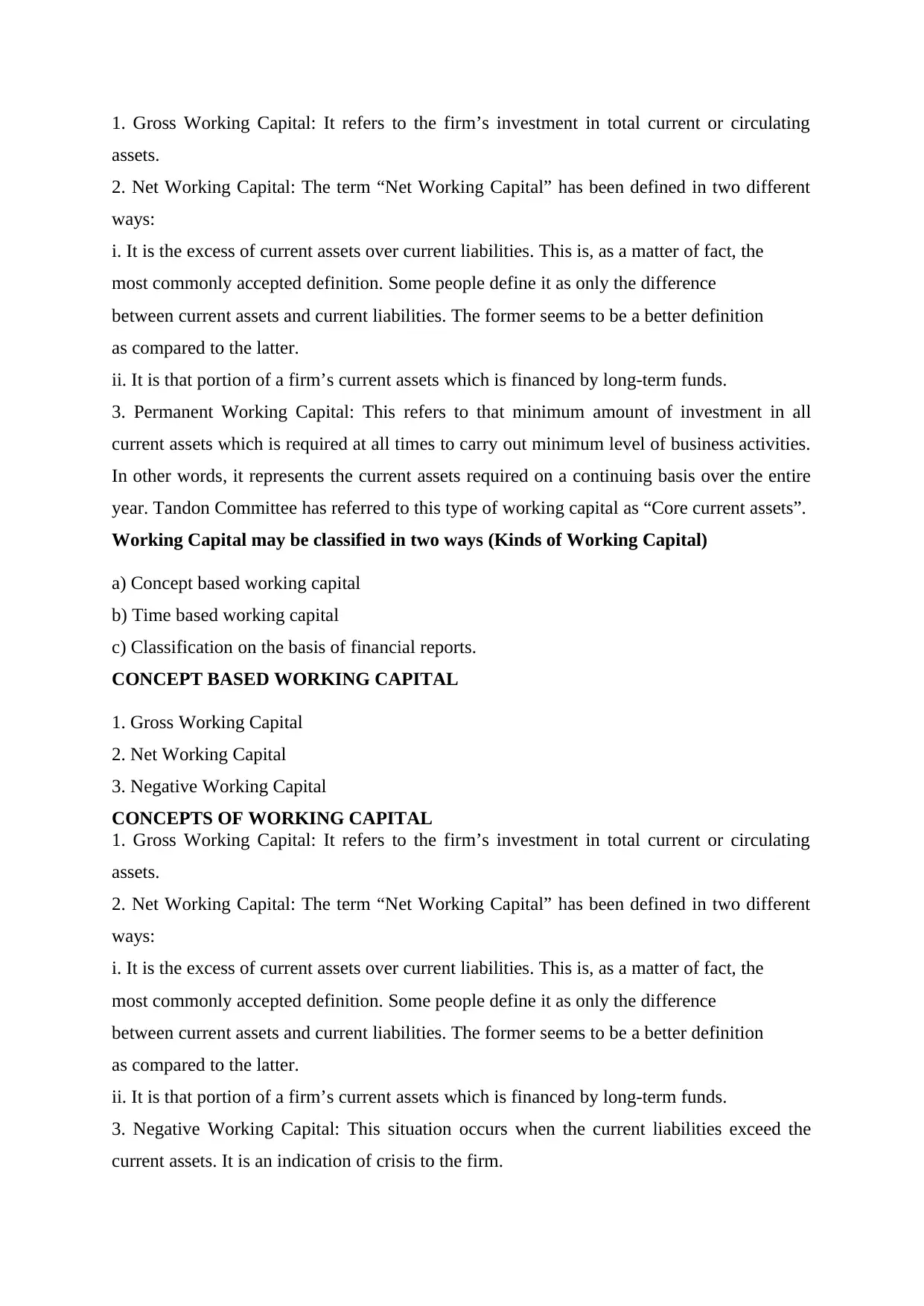
1. Gross Working Capital: It refers to the firm’s investment in total current or circulating
assets.
2. Net Working Capital: The term “Net Working Capital” has been defined in two different
ways:
i. It is the excess of current assets over current liabilities. This is, as a matter of fact, the
most commonly accepted definition. Some people define it as only the difference
between current assets and current liabilities. The former seems to be a better definition
as compared to the latter.
ii. It is that portion of a firm’s current assets which is financed by long-term funds.
3. Permanent Working Capital: This refers to that minimum amount of investment in all
current assets which is required at all times to carry out minimum level of business activities.
In other words, it represents the current assets required on a continuing basis over the entire
year. Tandon Committee has referred to this type of working capital as “Core current assets”.
Working Capital may be classified in two ways (Kinds of Working Capital)
a) Concept based working capital
b) Time based working capital
c) Classification on the basis of financial reports.
CONCEPT BASED WORKING CAPITAL
1. Gross Working Capital
2. Net Working Capital
3. Negative Working Capital
CONCEPTS OF WORKING CAPITAL
1. Gross Working Capital: It refers to the firm’s investment in total current or circulating
assets.
2. Net Working Capital: The term “Net Working Capital” has been defined in two different
ways:
i. It is the excess of current assets over current liabilities. This is, as a matter of fact, the
most commonly accepted definition. Some people define it as only the difference
between current assets and current liabilities. The former seems to be a better definition
as compared to the latter.
ii. It is that portion of a firm’s current assets which is financed by long-term funds.
3. Negative Working Capital: This situation occurs when the current liabilities exceed the
current assets. It is an indication of crisis to the firm.
assets.
2. Net Working Capital: The term “Net Working Capital” has been defined in two different
ways:
i. It is the excess of current assets over current liabilities. This is, as a matter of fact, the
most commonly accepted definition. Some people define it as only the difference
between current assets and current liabilities. The former seems to be a better definition
as compared to the latter.
ii. It is that portion of a firm’s current assets which is financed by long-term funds.
3. Permanent Working Capital: This refers to that minimum amount of investment in all
current assets which is required at all times to carry out minimum level of business activities.
In other words, it represents the current assets required on a continuing basis over the entire
year. Tandon Committee has referred to this type of working capital as “Core current assets”.
Working Capital may be classified in two ways (Kinds of Working Capital)
a) Concept based working capital
b) Time based working capital
c) Classification on the basis of financial reports.
CONCEPT BASED WORKING CAPITAL
1. Gross Working Capital
2. Net Working Capital
3. Negative Working Capital
CONCEPTS OF WORKING CAPITAL
1. Gross Working Capital: It refers to the firm’s investment in total current or circulating
assets.
2. Net Working Capital: The term “Net Working Capital” has been defined in two different
ways:
i. It is the excess of current assets over current liabilities. This is, as a matter of fact, the
most commonly accepted definition. Some people define it as only the difference
between current assets and current liabilities. The former seems to be a better definition
as compared to the latter.
ii. It is that portion of a firm’s current assets which is financed by long-term funds.
3. Negative Working Capital: This situation occurs when the current liabilities exceed the
current assets. It is an indication of crisis to the firm.
Paraphrase This Document
Need a fresh take? Get an instant paraphrase of this document with our AI Paraphraser
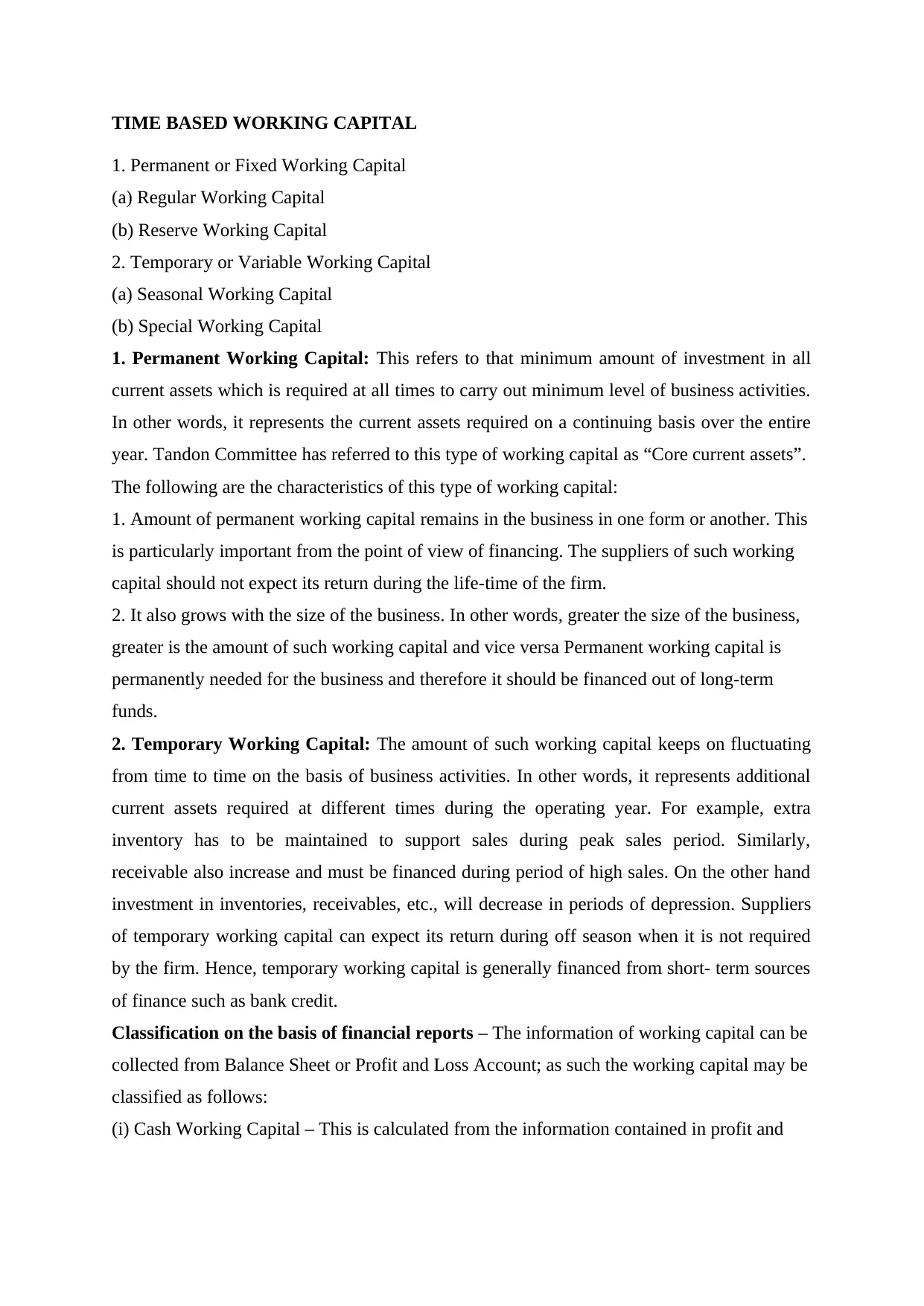
TIME BASED WORKING CAPITAL
1. Permanent or Fixed Working Capital
(a) Regular Working Capital
(b) Reserve Working Capital
2. Temporary or Variable Working Capital
(a) Seasonal Working Capital
(b) Special Working Capital
1. Permanent Working Capital: This refers to that minimum amount of investment in all
current assets which is required at all times to carry out minimum level of business activities.
In other words, it represents the current assets required on a continuing basis over the entire
year. Tandon Committee has referred to this type of working capital as “Core current assets”.
The following are the characteristics of this type of working capital:
1. Amount of permanent working capital remains in the business in one form or another. This
is particularly important from the point of view of financing. The suppliers of such working
capital should not expect its return during the life-time of the firm.
2. It also grows with the size of the business. In other words, greater the size of the business,
greater is the amount of such working capital and vice versa Permanent working capital is
permanently needed for the business and therefore it should be financed out of long-term
funds.
2. Temporary Working Capital: The amount of such working capital keeps on fluctuating
from time to time on the basis of business activities. In other words, it represents additional
current assets required at different times during the operating year. For example, extra
inventory has to be maintained to support sales during peak sales period. Similarly,
receivable also increase and must be financed during period of high sales. On the other hand
investment in inventories, receivables, etc., will decrease in periods of depression. Suppliers
of temporary working capital can expect its return during off season when it is not required
by the firm. Hence, temporary working capital is generally financed from short- term sources
of finance such as bank credit.
Classification on the basis of financial reports – The information of working capital can be
collected from Balance Sheet or Profit and Loss Account; as such the working capital may be
classified as follows:
(i) Cash Working Capital – This is calculated from the information contained in profit and
1. Permanent or Fixed Working Capital
(a) Regular Working Capital
(b) Reserve Working Capital
2. Temporary or Variable Working Capital
(a) Seasonal Working Capital
(b) Special Working Capital
1. Permanent Working Capital: This refers to that minimum amount of investment in all
current assets which is required at all times to carry out minimum level of business activities.
In other words, it represents the current assets required on a continuing basis over the entire
year. Tandon Committee has referred to this type of working capital as “Core current assets”.
The following are the characteristics of this type of working capital:
1. Amount of permanent working capital remains in the business in one form or another. This
is particularly important from the point of view of financing. The suppliers of such working
capital should not expect its return during the life-time of the firm.
2. It also grows with the size of the business. In other words, greater the size of the business,
greater is the amount of such working capital and vice versa Permanent working capital is
permanently needed for the business and therefore it should be financed out of long-term
funds.
2. Temporary Working Capital: The amount of such working capital keeps on fluctuating
from time to time on the basis of business activities. In other words, it represents additional
current assets required at different times during the operating year. For example, extra
inventory has to be maintained to support sales during peak sales period. Similarly,
receivable also increase and must be financed during period of high sales. On the other hand
investment in inventories, receivables, etc., will decrease in periods of depression. Suppliers
of temporary working capital can expect its return during off season when it is not required
by the firm. Hence, temporary working capital is generally financed from short- term sources
of finance such as bank credit.
Classification on the basis of financial reports – The information of working capital can be
collected from Balance Sheet or Profit and Loss Account; as such the working capital may be
classified as follows:
(i) Cash Working Capital – This is calculated from the information contained in profit and
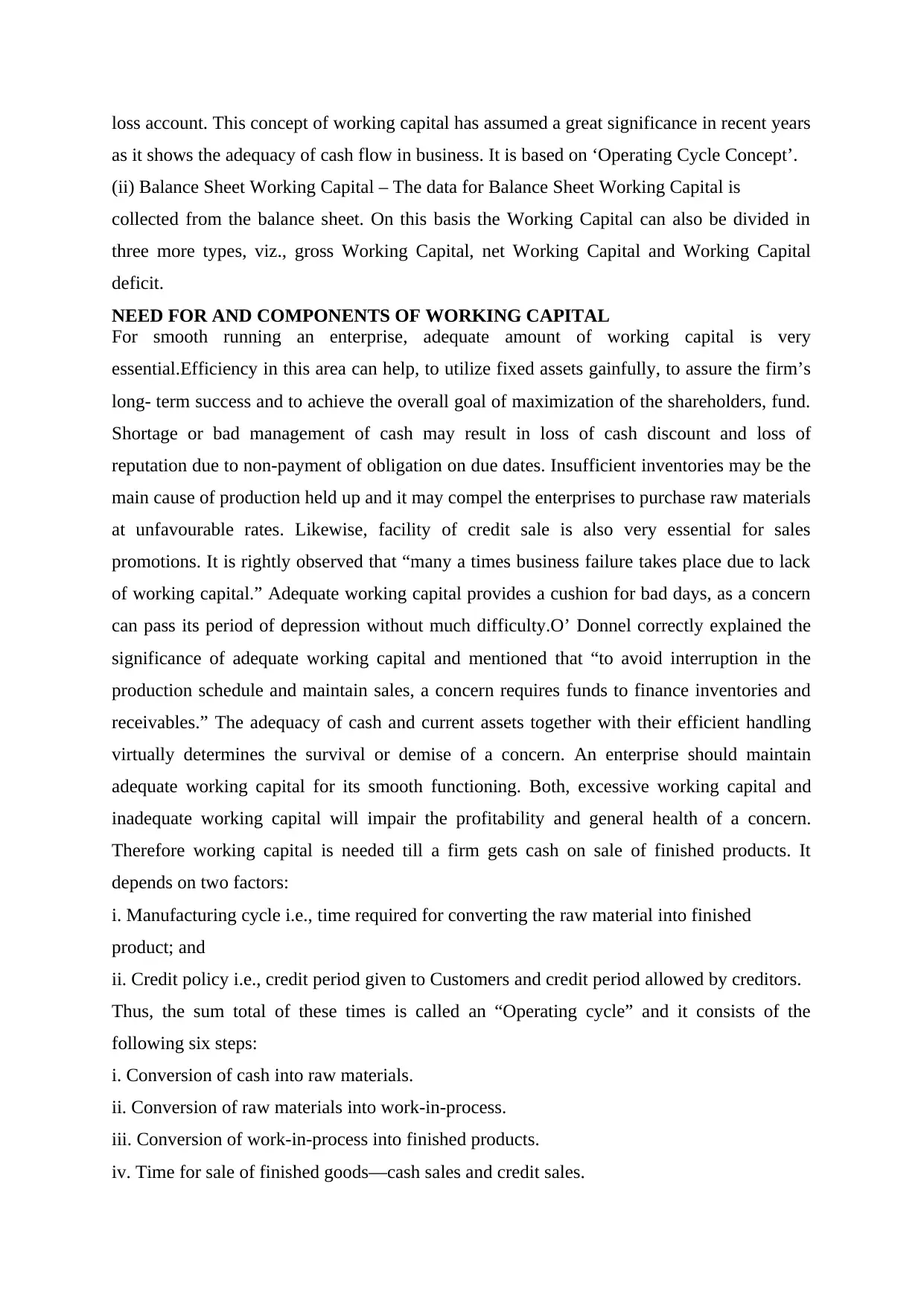
loss account. This concept of working capital has assumed a great significance in recent years
as it shows the adequacy of cash flow in business. It is based on ‘Operating Cycle Concept’.
(ii) Balance Sheet Working Capital – The data for Balance Sheet Working Capital is
collected from the balance sheet. On this basis the Working Capital can also be divided in
three more types, viz., gross Working Capital, net Working Capital and Working Capital
deficit.
NEED FOR AND COMPONENTS OF WORKING CAPITAL
For smooth running an enterprise, adequate amount of working capital is very
essential.Efficiency in this area can help, to utilize fixed assets gainfully, to assure the firm’s
long- term success and to achieve the overall goal of maximization of the shareholders, fund.
Shortage or bad management of cash may result in loss of cash discount and loss of
reputation due to non-payment of obligation on due dates. Insufficient inventories may be the
main cause of production held up and it may compel the enterprises to purchase raw materials
at unfavourable rates. Likewise, facility of credit sale is also very essential for sales
promotions. It is rightly observed that “many a times business failure takes place due to lack
of working capital.” Adequate working capital provides a cushion for bad days, as a concern
can pass its period of depression without much difficulty.O’ Donnel correctly explained the
significance of adequate working capital and mentioned that “to avoid interruption in the
production schedule and maintain sales, a concern requires funds to finance inventories and
receivables.” The adequacy of cash and current assets together with their efficient handling
virtually determines the survival or demise of a concern. An enterprise should maintain
adequate working capital for its smooth functioning. Both, excessive working capital and
inadequate working capital will impair the profitability and general health of a concern.
Therefore working capital is needed till a firm gets cash on sale of finished products. It
depends on two factors:
i. Manufacturing cycle i.e., time required for converting the raw material into finished
product; and
ii. Credit policy i.e., credit period given to Customers and credit period allowed by creditors.
Thus, the sum total of these times is called an “Operating cycle” and it consists of the
following six steps:
i. Conversion of cash into raw materials.
ii. Conversion of raw materials into work-in-process.
iii. Conversion of work-in-process into finished products.
iv. Time for sale of finished goods—cash sales and credit sales.
as it shows the adequacy of cash flow in business. It is based on ‘Operating Cycle Concept’.
(ii) Balance Sheet Working Capital – The data for Balance Sheet Working Capital is
collected from the balance sheet. On this basis the Working Capital can also be divided in
three more types, viz., gross Working Capital, net Working Capital and Working Capital
deficit.
NEED FOR AND COMPONENTS OF WORKING CAPITAL
For smooth running an enterprise, adequate amount of working capital is very
essential.Efficiency in this area can help, to utilize fixed assets gainfully, to assure the firm’s
long- term success and to achieve the overall goal of maximization of the shareholders, fund.
Shortage or bad management of cash may result in loss of cash discount and loss of
reputation due to non-payment of obligation on due dates. Insufficient inventories may be the
main cause of production held up and it may compel the enterprises to purchase raw materials
at unfavourable rates. Likewise, facility of credit sale is also very essential for sales
promotions. It is rightly observed that “many a times business failure takes place due to lack
of working capital.” Adequate working capital provides a cushion for bad days, as a concern
can pass its period of depression without much difficulty.O’ Donnel correctly explained the
significance of adequate working capital and mentioned that “to avoid interruption in the
production schedule and maintain sales, a concern requires funds to finance inventories and
receivables.” The adequacy of cash and current assets together with their efficient handling
virtually determines the survival or demise of a concern. An enterprise should maintain
adequate working capital for its smooth functioning. Both, excessive working capital and
inadequate working capital will impair the profitability and general health of a concern.
Therefore working capital is needed till a firm gets cash on sale of finished products. It
depends on two factors:
i. Manufacturing cycle i.e., time required for converting the raw material into finished
product; and
ii. Credit policy i.e., credit period given to Customers and credit period allowed by creditors.
Thus, the sum total of these times is called an “Operating cycle” and it consists of the
following six steps:
i. Conversion of cash into raw materials.
ii. Conversion of raw materials into work-in-process.
iii. Conversion of work-in-process into finished products.
iv. Time for sale of finished goods—cash sales and credit sales.
⊘ This is a preview!⊘
Do you want full access?
Subscribe today to unlock all pages.

Trusted by 1+ million students worldwide
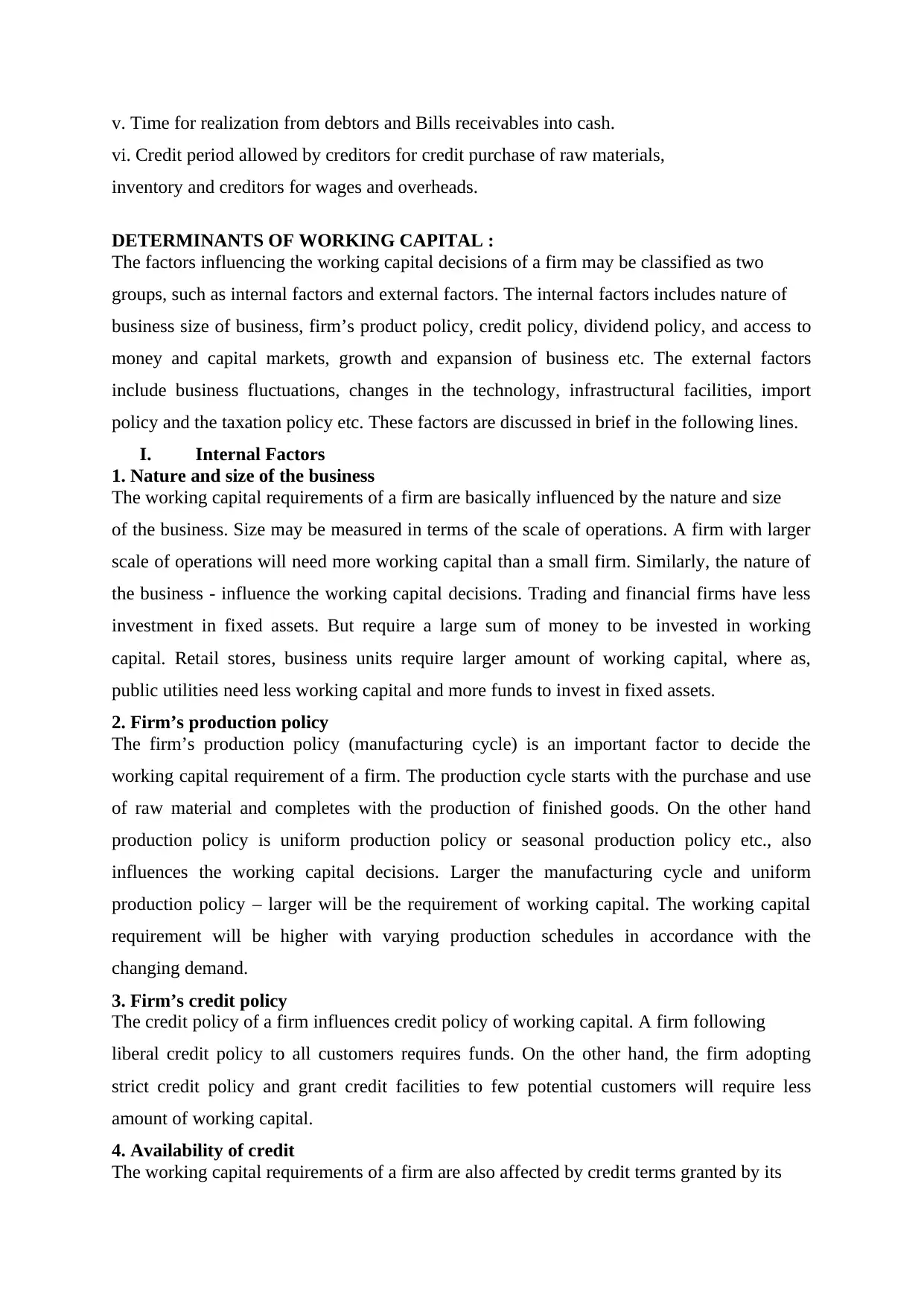
v. Time for realization from debtors and Bills receivables into cash.
vi. Credit period allowed by creditors for credit purchase of raw materials,
inventory and creditors for wages and overheads.
DETERMINANTS OF WORKING CAPITAL :
The factors influencing the working capital decisions of a firm may be classified as two
groups, such as internal factors and external factors. The internal factors includes nature of
business size of business, firm’s product policy, credit policy, dividend policy, and access to
money and capital markets, growth and expansion of business etc. The external factors
include business fluctuations, changes in the technology, infrastructural facilities, import
policy and the taxation policy etc. These factors are discussed in brief in the following lines.
I. Internal Factors
1. Nature and size of the business
The working capital requirements of a firm are basically influenced by the nature and size
of the business. Size may be measured in terms of the scale of operations. A firm with larger
scale of operations will need more working capital than a small firm. Similarly, the nature of
the business - influence the working capital decisions. Trading and financial firms have less
investment in fixed assets. But require a large sum of money to be invested in working
capital. Retail stores, business units require larger amount of working capital, where as,
public utilities need less working capital and more funds to invest in fixed assets.
2. Firm’s production policy
The firm’s production policy (manufacturing cycle) is an important factor to decide the
working capital requirement of a firm. The production cycle starts with the purchase and use
of raw material and completes with the production of finished goods. On the other hand
production policy is uniform production policy or seasonal production policy etc., also
influences the working capital decisions. Larger the manufacturing cycle and uniform
production policy – larger will be the requirement of working capital. The working capital
requirement will be higher with varying production schedules in accordance with the
changing demand.
3. Firm’s credit policy
The credit policy of a firm influences credit policy of working capital. A firm following
liberal credit policy to all customers requires funds. On the other hand, the firm adopting
strict credit policy and grant credit facilities to few potential customers will require less
amount of working capital.
4. Availability of credit
The working capital requirements of a firm are also affected by credit terms granted by its
vi. Credit period allowed by creditors for credit purchase of raw materials,
inventory and creditors for wages and overheads.
DETERMINANTS OF WORKING CAPITAL :
The factors influencing the working capital decisions of a firm may be classified as two
groups, such as internal factors and external factors. The internal factors includes nature of
business size of business, firm’s product policy, credit policy, dividend policy, and access to
money and capital markets, growth and expansion of business etc. The external factors
include business fluctuations, changes in the technology, infrastructural facilities, import
policy and the taxation policy etc. These factors are discussed in brief in the following lines.
I. Internal Factors
1. Nature and size of the business
The working capital requirements of a firm are basically influenced by the nature and size
of the business. Size may be measured in terms of the scale of operations. A firm with larger
scale of operations will need more working capital than a small firm. Similarly, the nature of
the business - influence the working capital decisions. Trading and financial firms have less
investment in fixed assets. But require a large sum of money to be invested in working
capital. Retail stores, business units require larger amount of working capital, where as,
public utilities need less working capital and more funds to invest in fixed assets.
2. Firm’s production policy
The firm’s production policy (manufacturing cycle) is an important factor to decide the
working capital requirement of a firm. The production cycle starts with the purchase and use
of raw material and completes with the production of finished goods. On the other hand
production policy is uniform production policy or seasonal production policy etc., also
influences the working capital decisions. Larger the manufacturing cycle and uniform
production policy – larger will be the requirement of working capital. The working capital
requirement will be higher with varying production schedules in accordance with the
changing demand.
3. Firm’s credit policy
The credit policy of a firm influences credit policy of working capital. A firm following
liberal credit policy to all customers requires funds. On the other hand, the firm adopting
strict credit policy and grant credit facilities to few potential customers will require less
amount of working capital.
4. Availability of credit
The working capital requirements of a firm are also affected by credit terms granted by its
Paraphrase This Document
Need a fresh take? Get an instant paraphrase of this document with our AI Paraphraser
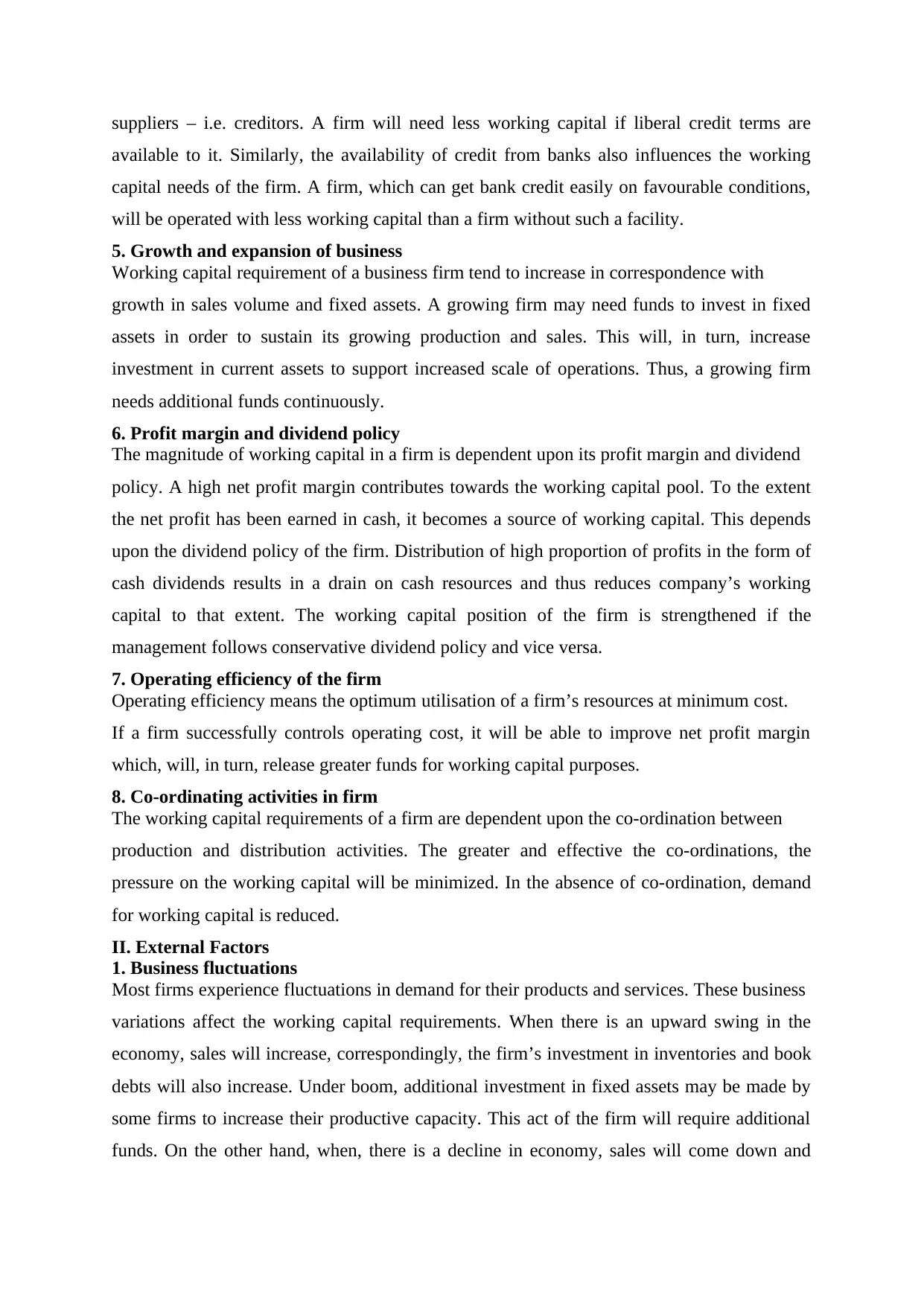
suppliers – i.e. creditors. A firm will need less working capital if liberal credit terms are
available to it. Similarly, the availability of credit from banks also influences the working
capital needs of the firm. A firm, which can get bank credit easily on favourable conditions,
will be operated with less working capital than a firm without such a facility.
5. Growth and expansion of business
Working capital requirement of a business firm tend to increase in correspondence with
growth in sales volume and fixed assets. A growing firm may need funds to invest in fixed
assets in order to sustain its growing production and sales. This will, in turn, increase
investment in current assets to support increased scale of operations. Thus, a growing firm
needs additional funds continuously.
6. Profit margin and dividend policy
The magnitude of working capital in a firm is dependent upon its profit margin and dividend
policy. A high net profit margin contributes towards the working capital pool. To the extent
the net profit has been earned in cash, it becomes a source of working capital. This depends
upon the dividend policy of the firm. Distribution of high proportion of profits in the form of
cash dividends results in a drain on cash resources and thus reduces company’s working
capital to that extent. The working capital position of the firm is strengthened if the
management follows conservative dividend policy and vice versa.
7. Operating efficiency of the firm
Operating efficiency means the optimum utilisation of a firm’s resources at minimum cost.
If a firm successfully controls operating cost, it will be able to improve net profit margin
which, will, in turn, release greater funds for working capital purposes.
8. Co-ordinating activities in firm
The working capital requirements of a firm are dependent upon the co-ordination between
production and distribution activities. The greater and effective the co-ordinations, the
pressure on the working capital will be minimized. In the absence of co-ordination, demand
for working capital is reduced.
II. External Factors
1. Business fluctuations
Most firms experience fluctuations in demand for their products and services. These business
variations affect the working capital requirements. When there is an upward swing in the
economy, sales will increase, correspondingly, the firm’s investment in inventories and book
debts will also increase. Under boom, additional investment in fixed assets may be made by
some firms to increase their productive capacity. This act of the firm will require additional
funds. On the other hand, when, there is a decline in economy, sales will come down and
available to it. Similarly, the availability of credit from banks also influences the working
capital needs of the firm. A firm, which can get bank credit easily on favourable conditions,
will be operated with less working capital than a firm without such a facility.
5. Growth and expansion of business
Working capital requirement of a business firm tend to increase in correspondence with
growth in sales volume and fixed assets. A growing firm may need funds to invest in fixed
assets in order to sustain its growing production and sales. This will, in turn, increase
investment in current assets to support increased scale of operations. Thus, a growing firm
needs additional funds continuously.
6. Profit margin and dividend policy
The magnitude of working capital in a firm is dependent upon its profit margin and dividend
policy. A high net profit margin contributes towards the working capital pool. To the extent
the net profit has been earned in cash, it becomes a source of working capital. This depends
upon the dividend policy of the firm. Distribution of high proportion of profits in the form of
cash dividends results in a drain on cash resources and thus reduces company’s working
capital to that extent. The working capital position of the firm is strengthened if the
management follows conservative dividend policy and vice versa.
7. Operating efficiency of the firm
Operating efficiency means the optimum utilisation of a firm’s resources at minimum cost.
If a firm successfully controls operating cost, it will be able to improve net profit margin
which, will, in turn, release greater funds for working capital purposes.
8. Co-ordinating activities in firm
The working capital requirements of a firm are dependent upon the co-ordination between
production and distribution activities. The greater and effective the co-ordinations, the
pressure on the working capital will be minimized. In the absence of co-ordination, demand
for working capital is reduced.
II. External Factors
1. Business fluctuations
Most firms experience fluctuations in demand for their products and services. These business
variations affect the working capital requirements. When there is an upward swing in the
economy, sales will increase, correspondingly, the firm’s investment in inventories and book
debts will also increase. Under boom, additional investment in fixed assets may be made by
some firms to increase their productive capacity. This act of the firm will require additional
funds. On the other hand, when, there is a decline in economy, sales will come down and
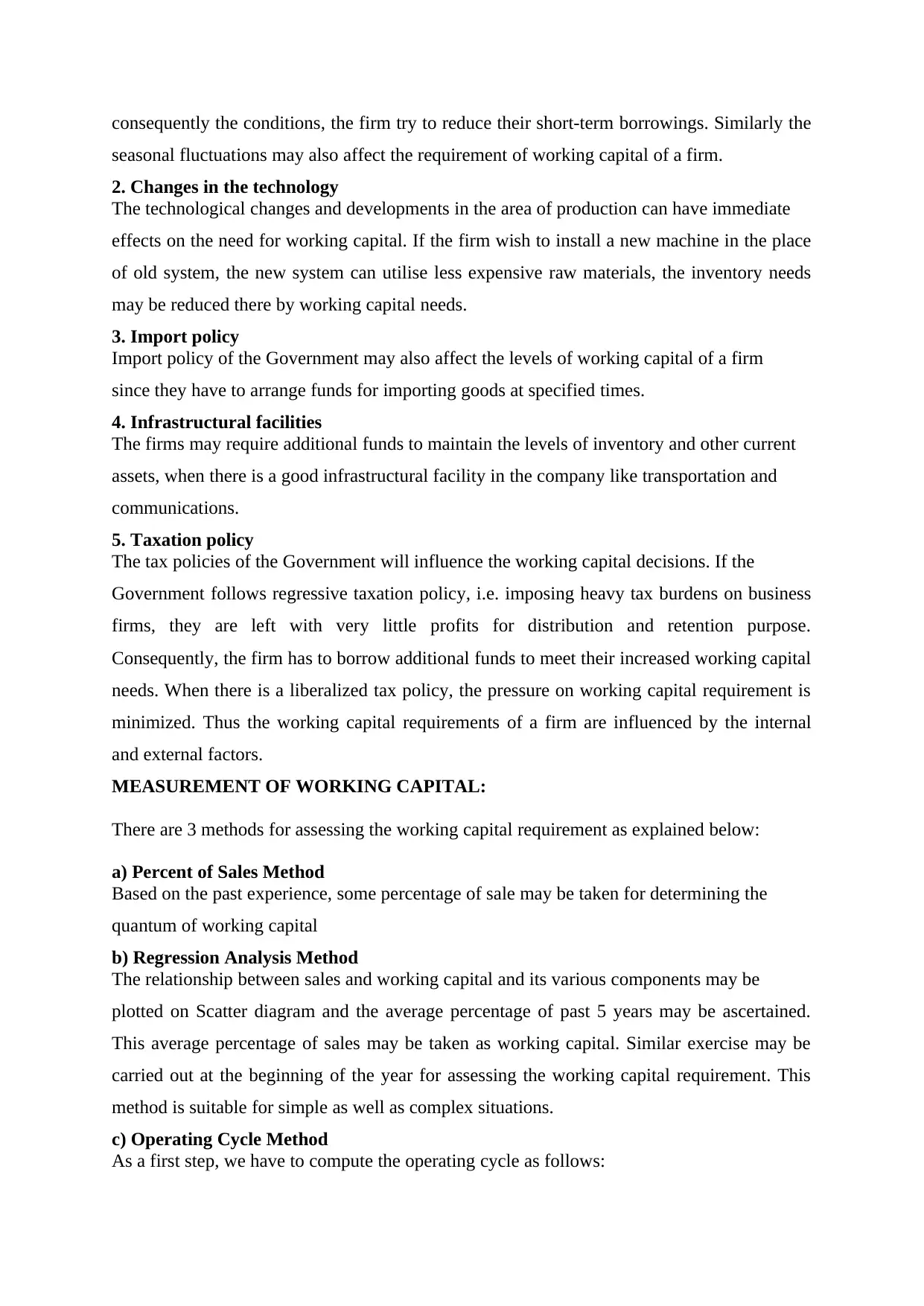
consequently the conditions, the firm try to reduce their short-term borrowings. Similarly the
seasonal fluctuations may also affect the requirement of working capital of a firm.
2. Changes in the technology
The technological changes and developments in the area of production can have immediate
effects on the need for working capital. If the firm wish to install a new machine in the place
of old system, the new system can utilise less expensive raw materials, the inventory needs
may be reduced there by working capital needs.
3. Import policy
Import policy of the Government may also affect the levels of working capital of a firm
since they have to arrange funds for importing goods at specified times.
4. Infrastructural facilities
The firms may require additional funds to maintain the levels of inventory and other current
assets, when there is a good infrastructural facility in the company like transportation and
communications.
5. Taxation policy
The tax policies of the Government will influence the working capital decisions. If the
Government follows regressive taxation policy, i.e. imposing heavy tax burdens on business
firms, they are left with very little profits for distribution and retention purpose.
Consequently, the firm has to borrow additional funds to meet their increased working capital
needs. When there is a liberalized tax policy, the pressure on working capital requirement is
minimized. Thus the working capital requirements of a firm are influenced by the internal
and external factors.
MEASUREMENT OF WORKING CAPITAL:
There are 3 methods for assessing the working capital requirement as explained below:
a) Percent of Sales Method
Based on the past experience, some percentage of sale may be taken for determining the
quantum of working capital
b) Regression Analysis Method
The relationship between sales and working capital and its various components may be
plotted on Scatter diagram and the average percentage of past 5 years may be ascertained.
This average percentage of sales may be taken as working capital. Similar exercise may be
carried out at the beginning of the year for assessing the working capital requirement. This
method is suitable for simple as well as complex situations.
c) Operating Cycle Method
As a first step, we have to compute the operating cycle as follows:
seasonal fluctuations may also affect the requirement of working capital of a firm.
2. Changes in the technology
The technological changes and developments in the area of production can have immediate
effects on the need for working capital. If the firm wish to install a new machine in the place
of old system, the new system can utilise less expensive raw materials, the inventory needs
may be reduced there by working capital needs.
3. Import policy
Import policy of the Government may also affect the levels of working capital of a firm
since they have to arrange funds for importing goods at specified times.
4. Infrastructural facilities
The firms may require additional funds to maintain the levels of inventory and other current
assets, when there is a good infrastructural facility in the company like transportation and
communications.
5. Taxation policy
The tax policies of the Government will influence the working capital decisions. If the
Government follows regressive taxation policy, i.e. imposing heavy tax burdens on business
firms, they are left with very little profits for distribution and retention purpose.
Consequently, the firm has to borrow additional funds to meet their increased working capital
needs. When there is a liberalized tax policy, the pressure on working capital requirement is
minimized. Thus the working capital requirements of a firm are influenced by the internal
and external factors.
MEASUREMENT OF WORKING CAPITAL:
There are 3 methods for assessing the working capital requirement as explained below:
a) Percent of Sales Method
Based on the past experience, some percentage of sale may be taken for determining the
quantum of working capital
b) Regression Analysis Method
The relationship between sales and working capital and its various components may be
plotted on Scatter diagram and the average percentage of past 5 years may be ascertained.
This average percentage of sales may be taken as working capital. Similar exercise may be
carried out at the beginning of the year for assessing the working capital requirement. This
method is suitable for simple as well as complex situations.
c) Operating Cycle Method
As a first step, we have to compute the operating cycle as follows:
⊘ This is a preview!⊘
Do you want full access?
Subscribe today to unlock all pages.

Trusted by 1+ million students worldwide
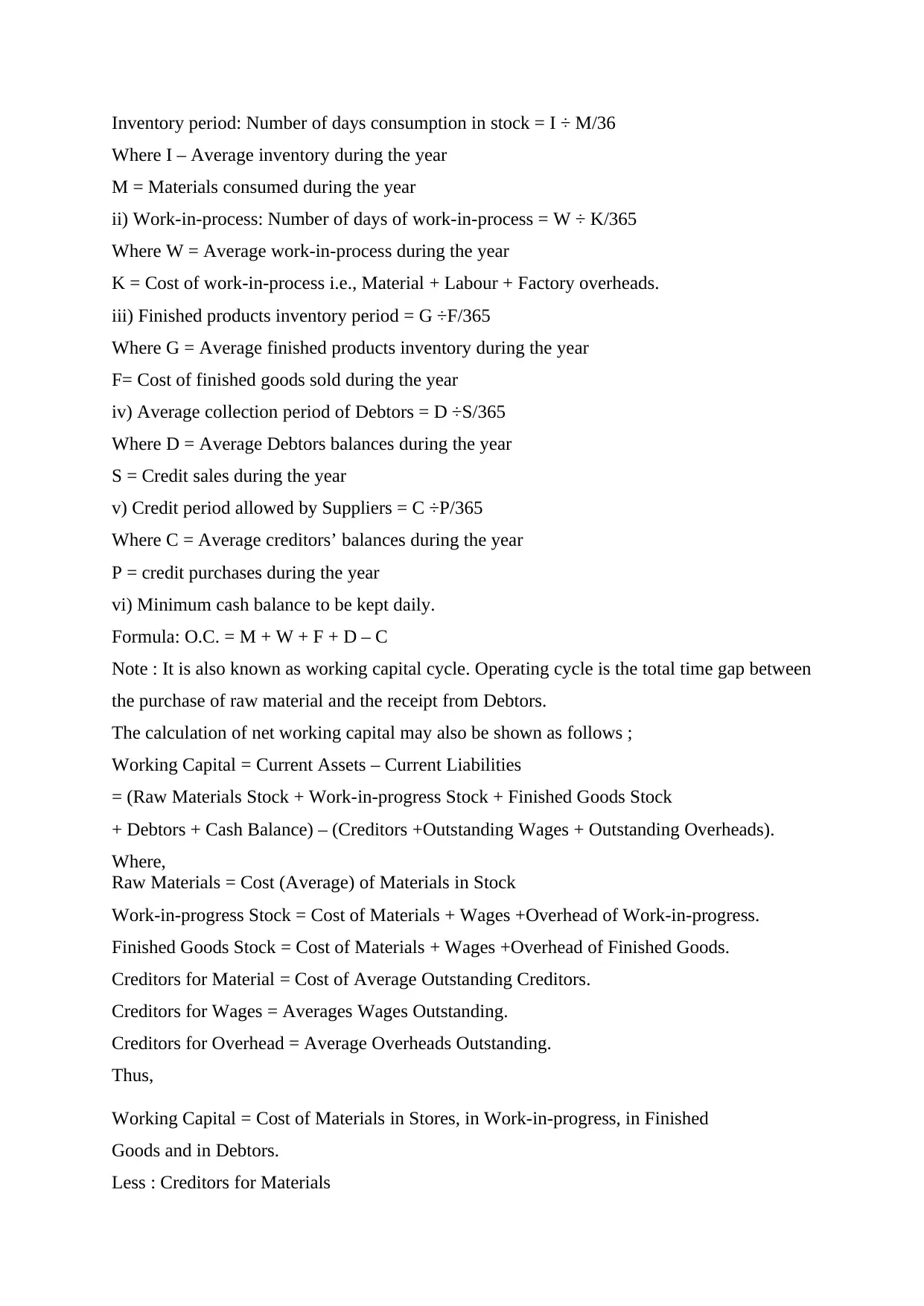
Inventory period: Number of days consumption in stock = I ÷ M/36
Where I – Average inventory during the year
M = Materials consumed during the year
ii) Work-in-process: Number of days of work-in-process = W ÷ K/365
Where W = Average work-in-process during the year
K = Cost of work-in-process i.e., Material + Labour + Factory overheads.
iii) Finished products inventory period = G ÷F/365
Where G = Average finished products inventory during the year
F= Cost of finished goods sold during the year
iv) Average collection period of Debtors = D ÷S/365
Where D = Average Debtors balances during the year
S = Credit sales during the year
v) Credit period allowed by Suppliers = C ÷P/365
Where C = Average creditors’ balances during the year
P = credit purchases during the year
vi) Minimum cash balance to be kept daily.
Formula: O.C. = M + W + F + D – C
Note : It is also known as working capital cycle. Operating cycle is the total time gap between
the purchase of raw material and the receipt from Debtors.
The calculation of net working capital may also be shown as follows ;
Working Capital = Current Assets – Current Liabilities
= (Raw Materials Stock + Work-in-progress Stock + Finished Goods Stock
+ Debtors + Cash Balance) – (Creditors +Outstanding Wages + Outstanding Overheads).
Where,
Raw Materials = Cost (Average) of Materials in Stock
Work-in-progress Stock = Cost of Materials + Wages +Overhead of Work-in-progress.
Finished Goods Stock = Cost of Materials + Wages +Overhead of Finished Goods.
Creditors for Material = Cost of Average Outstanding Creditors.
Creditors for Wages = Averages Wages Outstanding.
Creditors for Overhead = Average Overheads Outstanding.
Thus,
Working Capital = Cost of Materials in Stores, in Work-in-progress, in Finished
Goods and in Debtors.
Less : Creditors for Materials
Where I – Average inventory during the year
M = Materials consumed during the year
ii) Work-in-process: Number of days of work-in-process = W ÷ K/365
Where W = Average work-in-process during the year
K = Cost of work-in-process i.e., Material + Labour + Factory overheads.
iii) Finished products inventory period = G ÷F/365
Where G = Average finished products inventory during the year
F= Cost of finished goods sold during the year
iv) Average collection period of Debtors = D ÷S/365
Where D = Average Debtors balances during the year
S = Credit sales during the year
v) Credit period allowed by Suppliers = C ÷P/365
Where C = Average creditors’ balances during the year
P = credit purchases during the year
vi) Minimum cash balance to be kept daily.
Formula: O.C. = M + W + F + D – C
Note : It is also known as working capital cycle. Operating cycle is the total time gap between
the purchase of raw material and the receipt from Debtors.
The calculation of net working capital may also be shown as follows ;
Working Capital = Current Assets – Current Liabilities
= (Raw Materials Stock + Work-in-progress Stock + Finished Goods Stock
+ Debtors + Cash Balance) – (Creditors +Outstanding Wages + Outstanding Overheads).
Where,
Raw Materials = Cost (Average) of Materials in Stock
Work-in-progress Stock = Cost of Materials + Wages +Overhead of Work-in-progress.
Finished Goods Stock = Cost of Materials + Wages +Overhead of Finished Goods.
Creditors for Material = Cost of Average Outstanding Creditors.
Creditors for Wages = Averages Wages Outstanding.
Creditors for Overhead = Average Overheads Outstanding.
Thus,
Working Capital = Cost of Materials in Stores, in Work-in-progress, in Finished
Goods and in Debtors.
Less : Creditors for Materials
Paraphrase This Document
Need a fresh take? Get an instant paraphrase of this document with our AI Paraphraser
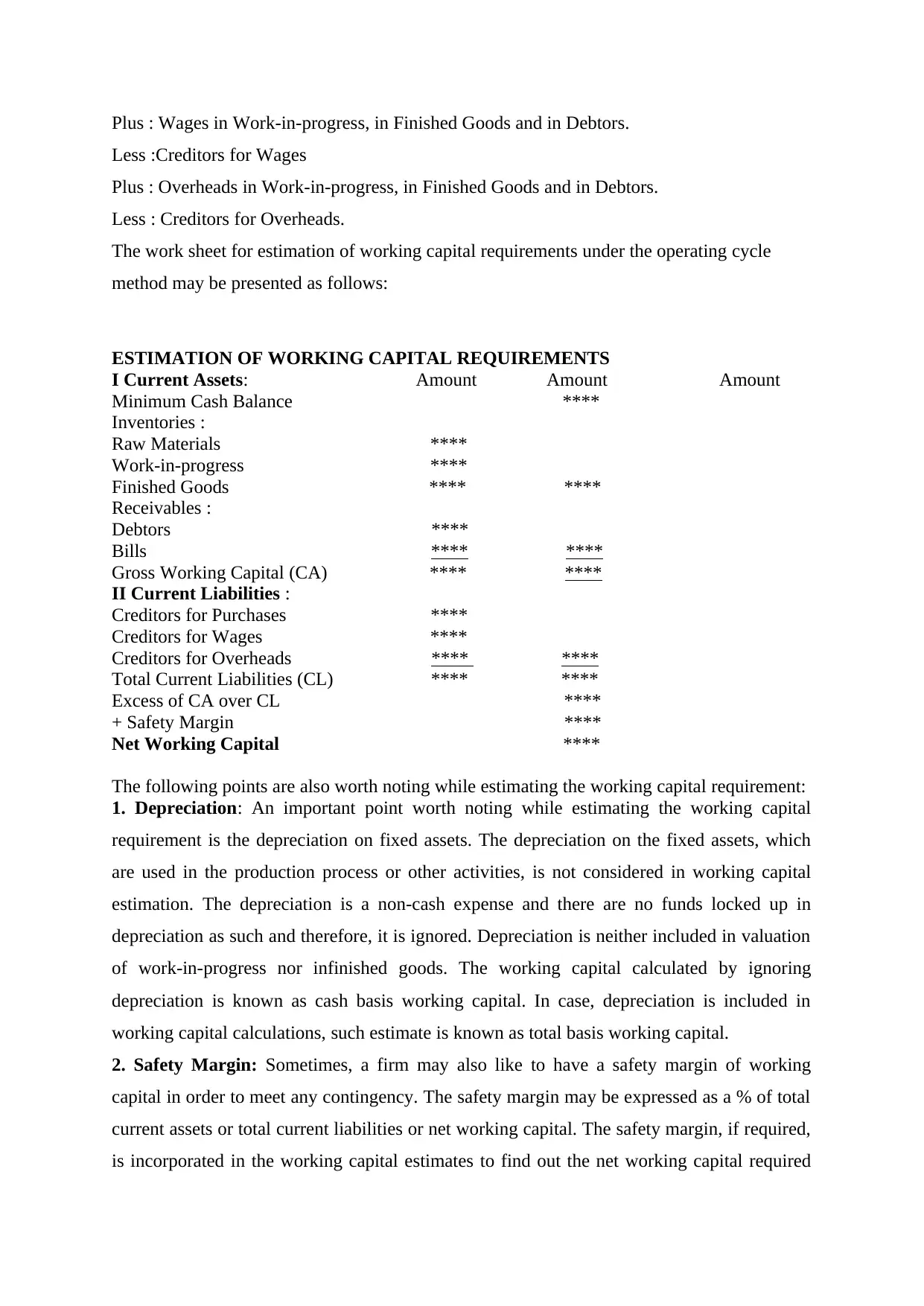
Plus : Wages in Work-in-progress, in Finished Goods and in Debtors.
Less :Creditors for Wages
Plus : Overheads in Work-in-progress, in Finished Goods and in Debtors.
Less : Creditors for Overheads.
The work sheet for estimation of working capital requirements under the operating cycle
method may be presented as follows:
ESTIMATION OF WORKING CAPITAL REQUIREMENTS
I Current Assets: Amount Amount Amount
Minimum Cash Balance ****
Inventories :
Raw Materials ****
Work-in-progress ****
Finished Goods **** ****
Receivables :
Debtors ****
Bills **** ****
Gross Working Capital (CA) **** ****
II Current Liabilities :
Creditors for Purchases ****
Creditors for Wages ****
Creditors for Overheads **** ****
Total Current Liabilities (CL) **** ****
Excess of CA over CL ****
+ Safety Margin ****
Net Working Capital ****
The following points are also worth noting while estimating the working capital requirement:
1. Depreciation: An important point worth noting while estimating the working capital
requirement is the depreciation on fixed assets. The depreciation on the fixed assets, which
are used in the production process or other activities, is not considered in working capital
estimation. The depreciation is a non-cash expense and there are no funds locked up in
depreciation as such and therefore, it is ignored. Depreciation is neither included in valuation
of work-in-progress nor infinished goods. The working capital calculated by ignoring
depreciation is known as cash basis working capital. In case, depreciation is included in
working capital calculations, such estimate is known as total basis working capital.
2. Safety Margin: Sometimes, a firm may also like to have a safety margin of working
capital in order to meet any contingency. The safety margin may be expressed as a % of total
current assets or total current liabilities or net working capital. The safety margin, if required,
is incorporated in the working capital estimates to find out the net working capital required
Less :Creditors for Wages
Plus : Overheads in Work-in-progress, in Finished Goods and in Debtors.
Less : Creditors for Overheads.
The work sheet for estimation of working capital requirements under the operating cycle
method may be presented as follows:
ESTIMATION OF WORKING CAPITAL REQUIREMENTS
I Current Assets: Amount Amount Amount
Minimum Cash Balance ****
Inventories :
Raw Materials ****
Work-in-progress ****
Finished Goods **** ****
Receivables :
Debtors ****
Bills **** ****
Gross Working Capital (CA) **** ****
II Current Liabilities :
Creditors for Purchases ****
Creditors for Wages ****
Creditors for Overheads **** ****
Total Current Liabilities (CL) **** ****
Excess of CA over CL ****
+ Safety Margin ****
Net Working Capital ****
The following points are also worth noting while estimating the working capital requirement:
1. Depreciation: An important point worth noting while estimating the working capital
requirement is the depreciation on fixed assets. The depreciation on the fixed assets, which
are used in the production process or other activities, is not considered in working capital
estimation. The depreciation is a non-cash expense and there are no funds locked up in
depreciation as such and therefore, it is ignored. Depreciation is neither included in valuation
of work-in-progress nor infinished goods. The working capital calculated by ignoring
depreciation is known as cash basis working capital. In case, depreciation is included in
working capital calculations, such estimate is known as total basis working capital.
2. Safety Margin: Sometimes, a firm may also like to have a safety margin of working
capital in order to meet any contingency. The safety margin may be expressed as a % of total
current assets or total current liabilities or net working capital. The safety margin, if required,
is incorporated in the working capital estimates to find out the net working capital required
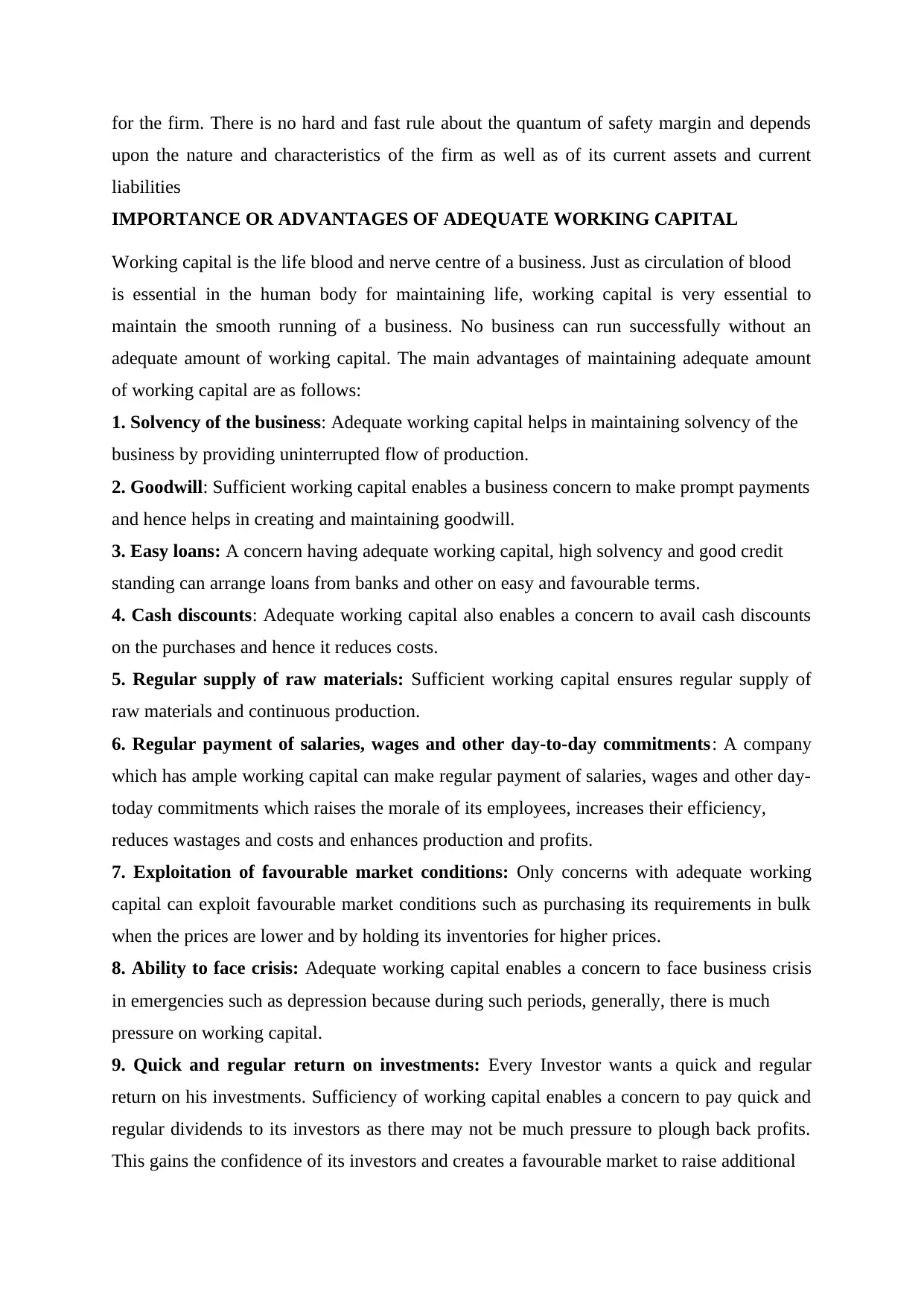
for the firm. There is no hard and fast rule about the quantum of safety margin and depends
upon the nature and characteristics of the firm as well as of its current assets and current
liabilities
IMPORTANCE OR ADVANTAGES OF ADEQUATE WORKING CAPITAL
Working capital is the life blood and nerve centre of a business. Just as circulation of blood
is essential in the human body for maintaining life, working capital is very essential to
maintain the smooth running of a business. No business can run successfully without an
adequate amount of working capital. The main advantages of maintaining adequate amount
of working capital are as follows:
1. Solvency of the business: Adequate working capital helps in maintaining solvency of the
business by providing uninterrupted flow of production.
2. Goodwill: Sufficient working capital enables a business concern to make prompt payments
and hence helps in creating and maintaining goodwill.
3. Easy loans: A concern having adequate working capital, high solvency and good credit
standing can arrange loans from banks and other on easy and favourable terms.
4. Cash discounts: Adequate working capital also enables a concern to avail cash discounts
on the purchases and hence it reduces costs.
5. Regular supply of raw materials: Sufficient working capital ensures regular supply of
raw materials and continuous production.
6. Regular payment of salaries, wages and other day-to-day commitments: A company
which has ample working capital can make regular payment of salaries, wages and other day-
today commitments which raises the morale of its employees, increases their efficiency,
reduces wastages and costs and enhances production and profits.
7. Exploitation of favourable market conditions: Only concerns with adequate working
capital can exploit favourable market conditions such as purchasing its requirements in bulk
when the prices are lower and by holding its inventories for higher prices.
8. Ability to face crisis: Adequate working capital enables a concern to face business crisis
in emergencies such as depression because during such periods, generally, there is much
pressure on working capital.
9. Quick and regular return on investments: Every Investor wants a quick and regular
return on his investments. Sufficiency of working capital enables a concern to pay quick and
regular dividends to its investors as there may not be much pressure to plough back profits.
This gains the confidence of its investors and creates a favourable market to raise additional
upon the nature and characteristics of the firm as well as of its current assets and current
liabilities
IMPORTANCE OR ADVANTAGES OF ADEQUATE WORKING CAPITAL
Working capital is the life blood and nerve centre of a business. Just as circulation of blood
is essential in the human body for maintaining life, working capital is very essential to
maintain the smooth running of a business. No business can run successfully without an
adequate amount of working capital. The main advantages of maintaining adequate amount
of working capital are as follows:
1. Solvency of the business: Adequate working capital helps in maintaining solvency of the
business by providing uninterrupted flow of production.
2. Goodwill: Sufficient working capital enables a business concern to make prompt payments
and hence helps in creating and maintaining goodwill.
3. Easy loans: A concern having adequate working capital, high solvency and good credit
standing can arrange loans from banks and other on easy and favourable terms.
4. Cash discounts: Adequate working capital also enables a concern to avail cash discounts
on the purchases and hence it reduces costs.
5. Regular supply of raw materials: Sufficient working capital ensures regular supply of
raw materials and continuous production.
6. Regular payment of salaries, wages and other day-to-day commitments: A company
which has ample working capital can make regular payment of salaries, wages and other day-
today commitments which raises the morale of its employees, increases their efficiency,
reduces wastages and costs and enhances production and profits.
7. Exploitation of favourable market conditions: Only concerns with adequate working
capital can exploit favourable market conditions such as purchasing its requirements in bulk
when the prices are lower and by holding its inventories for higher prices.
8. Ability to face crisis: Adequate working capital enables a concern to face business crisis
in emergencies such as depression because during such periods, generally, there is much
pressure on working capital.
9. Quick and regular return on investments: Every Investor wants a quick and regular
return on his investments. Sufficiency of working capital enables a concern to pay quick and
regular dividends to its investors as there may not be much pressure to plough back profits.
This gains the confidence of its investors and creates a favourable market to raise additional
⊘ This is a preview!⊘
Do you want full access?
Subscribe today to unlock all pages.

Trusted by 1+ million students worldwide
1 out of 13
Related Documents
Your All-in-One AI-Powered Toolkit for Academic Success.
+13062052269
info@desklib.com
Available 24*7 on WhatsApp / Email
![[object Object]](/_next/static/media/star-bottom.7253800d.svg)
Unlock your academic potential
Copyright © 2020–2025 A2Z Services. All Rights Reserved. Developed and managed by ZUCOL.





